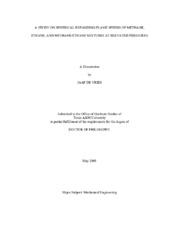| dc.contributor.advisor | Petersen, Eric L. | |
| dc.creator | De Vries, Jaap | |
| dc.date.accessioned | 2010-07-15T00:12:59Z | |
| dc.date.accessioned | 2010-07-23T21:44:22Z | |
| dc.date.available | 2010-07-15T00:12:59Z | |
| dc.date.available | 2010-07-23T21:44:22Z | |
| dc.date.created | 2009-05 | |
| dc.date.issued | 2010-07-14 | |
| dc.date.submitted | May 2009 | |
| dc.identifier.uri | https://hdl.handle.net/1969.1/ETD-TAMU-2009-05-601 | |
| dc.description.abstract | High-pressure experiments and chemical kinetics modeling were performed for laminar spherically expanding flames for methane/air, ethane/air, methane/ethane/air and propane/air mixtures at pressures between 1 and 10 atm and equivalence ratios ranging from 0.7 to 1.3. All experiments were performed in a new flame speed facility capable of withstanding initial pressures up to 15 atm. The facility consists of a cylindrical pressure vessel rated up to 2200 psi. Vacuums down to 30 mTorr were produced before each experiment, and mixtures were created using the partial pressure method. Ignition was obtained by an automotive coil and a constant current power supply capable of reducing the spark energy close to the minimum ignition energy.
Optical cine-photography was provided via a Z-type schlieren set up and a high-speed camera (2000 fps). A full description of the facility is given including a pressure rating and a computational conjugate heat transfer analysis predicting temperature rises at the walls. Additionally, a detailed uncertainty analysis revealed total uncertainty in measured flame speed of approximately +-0.7 cm/s. This study includes first-ever measurements of methane/ethane flame speeds at elevated pressures as well as unique high pressure ethane flame speed measurements.
Three chemical kinetic models were used and compared against measured flame velocities. GRI 3.0 performed remarkably well even for high-pressure ethane flames. The C5 mechanism performed acceptably at low pressure conditions and under-predicted the experimental data at elevated pressures.
Measured Markstein lengths of atmospheric methane/air flames were compared against values found in the literature. In this study, Markstein lengths increased for methane/air flames from fuel lean to fuel rich. A reverse trend was observed for ethane/air mixtures with the Markstein length decreasing from fuel lean to fuel rich conditions.
Flame cellularity was observed for mixtures at elevated pressures. For both methane and ethane, hydrodynamic instabilities dominated at stoichiometric conditions. Flame acceleration was clearly visible and used to determine the onset of cellular instabilities. The onset of flame acceleration for each high-pressure experiment was recorded. | en |
| dc.format.mimetype | application/pdf | |
| dc.language.iso | eng | |
| dc.subject | laminar flame speed, natural gas, methane, ethane, spherical flame, combustion, gas turbines, high pressure, flame stretch, Markstein length, Chemical kinetics, combustion modeling | en |
| dc.title | A STUDY ON SPHERICAL EXPANDING FLAME SPEEDS OF METHANE, ETHANE, AND METHANE/ETHANE MIXTURES AT ELEVATED PRESSURES | en |
| dc.type | Book | en |
| dc.type | Thesis | en |
| thesis.degree.department | Mechanical Engineering | en |
| thesis.degree.discipline | Mechanical Engineering | en |
| thesis.degree.grantor | Texas A&M University | en |
| thesis.degree.name | Doctor of Philosophy | en |
| thesis.degree.level | Doctoral | en |
| dc.contributor.committeeMember | Annamalai, Kalyan | |
| dc.contributor.committeeMember | Caton, Jerald A. | |
| dc.contributor.committeeMember | Hall, Kenneth R. | |
| dc.type.genre | Electronic Dissertation | en |
| dc.type.material | text | en |


